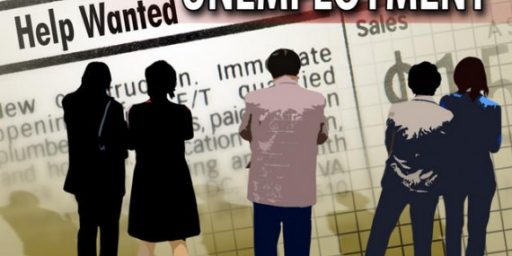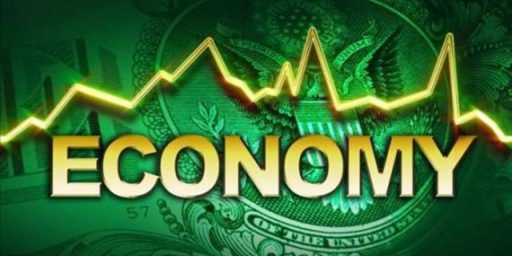IT’S THE ECONOMY, STUPID
WaPo reports a mild, but higher than expected, uptick in the economy.
The U.S. economy, lifted by consumer and business spending, broke out of the doldrums and grew at an annual rate of 2.4 percent in the second quarter of 2003, the strongest showing in nearly a year.
* * *
The report reinforced the hope that the nation’s economy, shedding war and other uncertainties that had bogged it down earlier, would gain more traction in the second half of this year.Considered the broadest barometer of the economy’s health, GDP measure the total value of goods and services produced within the United States.
The 2.4 percent growth rate turned in during the second quarter showed more energy than the limp 1.5 percent pace that economists were predicting. The second quarter’s performance was the best since the third quarter of 2002, when economic growth clocked in at a healthy 4 percent rate.
In another encouraging report, new applications filed last week for unemployment benefits dropped by 3,000 to a five-month low of 388,000, the Labor Department said. It marked the third week in a row that jobless claims went down and suggested that the pace of layoffs is stabilizing.
Meanwhile, a second Labor report showed that U.S. workers’ wages and benefits grew by 0.9 percent in the second quarter, down from a 1.3 percent rise in the previous quarter.
* * *
Fed Chairman Alan Greenspan and private economists believe the economy will stage a material rebound in the second half of this year. President Bush’s tax cuts along with near rock-bottom short-term interest rates should help out on that front, economists say. Some are predicting growth in the second half in the range of a 3.5 percent to 4 percent rate.Analysts believe the combination of lower borrowing costs and fatter paychecks and other tax incentives might spur consumers and businesses to spend and invest more.
* * *
Especially encouraging in the GDP report was budding signs that the big freeze on business spending is beginning to thaw. Businesses, which cut spending on equipment and software in the first three months of this year, boosted such investment in the second quarter at a sizable 7.5 percent rate. That marked the biggest increase in three years.
It’s about time for some good news. While I don’t think President Bush deserves much credit for the resurgence–or much blame for the recent doldrums–this will obviously be helpful to him in his bid for reelection. The economy had rebounded by the time his father was up for re-election in 1992, but happened too late to penetrate the public psyche.
The news is not all good, though:
[T]he job market is likely to remain sluggish economists say. The unemployment rate hit a nine-year high of 6.4 percent in June. It could hover in that range and possibly move higher in the months ahead because job growth probably will not be strong enough to handle an influx of people looking for work amid an improved climate, economists say.
Let’s hope the economists are right about the growth and wrong about the unemployment.





Unemployment tends to be a lagging indicator for recoveries, so this is not unexpected.
But what about the news that the States’ bleeding of red ink is proving a drain on the national economy.
How does one reconcile the apparently still-very-bad-news at the state level with an economic recovery?
The unemployment rate in the US has averaged about 6% for many, many years (since 1950, anyway). It’s only been in the last 10 years that it’s remained below 5% for any substantial period of time. I doubt some miracle of economics has occurred recently (especially given the “new economy” gibberish has been pretty much disproven by practical experience) that would cause the rate to stay that low.
Thoughts?
cj: The national economy is the national economy: an aggregate. If the state deficits are draining from the recovery, that presumably means the recovery would otherwise be more robust. And, of course, the growth isn’t uniformly spread; some states are almost certainly experiencing much higher growth rates and some much lower–or even negative–growth.
42nd SSD: There’s always the problem of relative deprivation, I guess. Even if we’re getting to the “norm” of 6% unemployment the perception would be that it’s high compared to recent memory or the fact that others around them are doing well.